
The Hiangle is a longstanding model in the Five Ten range. In this review we'll be looking at each of the three new models released late last year: the Hiangle, Hiangle LV (low volume) and Hiangle Pro. Given the similarity of features between the Hiangle and Hiangle LV we will review these two together with additional comments on fit, before taking a separate look at the Hiangle Pro.
Hiangle and Hiangle LV - RRP £120
Functionality
The Hiangle is best described as a supportive performance all-rounder, which could be used for either sport climbing or bouldering, indoors or out. Out of the box they feel a little stiff, which is perfect for more edge-based rock types (i.e. limestone, rhyolite); however, given a bit of use they soften up just the right amount, making them nice and sensitive, but not too floppy, which is ideal for more friction-based rock types (i.e. gritstone, sandstone and granite).
The abundance of rubber around the heel and toe makes them well suited to a more modern style of climbing, where you're going to be engaging in the intricacies of toe and heel hooks, marginal scums, and a whole host of other terms that may not have been made up yet.
Fit
Hiangle: The volume in the forefoot has changed a little from its predecessor, increasing slightly. As a result it's going to be more appropriate for climbers with medium-high volume feet, at the neutral to wide end of the spectrum. They're asymmetric in design, but not extremely so, with a slight curve and a more centralised toe profile.
Hiangle LV: It goes without saying that the LV has a lower volume, but we thought we'd say it anyway - just to get the ball rolling. Sometimes people confuse what low volume actually means, either seeing it as a 'women's fit' or another way of saying that it's narrow. Whilst both can apply, neither are strictly correct. Both men and women can use low volume shoes and low volume (ie. less depth) doesn't necessarily also mean narrow. In fact, in the case of the Hiangle LV I'd actually say they are - if anything - on the neutral end of the width spectrum, it's just that within that space there's less room (AKA. volume).

Uppers
On top there's a whole lot of rubber wrapped around the toe and sides, which (as mentioned above) makes it ideal not just for toe-hooking, but also for getting the most out of even the most marginal of scums. Sometimes this can be to the detriment of the fit, feel and comfort of a climbing shoe, as it takes them longer to wear in and adds greater pressure to the knuckles of your toes, but this isn't an issue we've experienced here. That said, we'd suggest trying before buying to ensure that they fit your feet, because if they don't you could potentially have the exact opposite experience.
The fastening consists of an elasticated slipper and a single velcro strap. The former gives it a good fit, hugging the foot, and keeping it feeling nice and snug. The velcro strap just adds further security and precision. One drawback of the slipper design is that it does take a bit of oomph to get on initially, but one positive is that once they are on they stay on - irrespective of the strap. In terms of getting them on I needed to use a piece of plastic to help slip my foot in for the first few times I wore them, but once on they were comfortable. Maybe you will need to do this too, maybe you won't, but bear in mind that given their synthetic/low-stretch upper, you don't want to be buying them too small. They give a bit, but not a lot, and if they're painful to begin with then they're probably going to be painful for a long time.
Midsole/Heel
The Hiangle has a supportive midsole, which runs through 2/3 of the length of the shoe. Out of the box this definitely feels quite stiff (and not in a bad way), which means that it's perfect for small edges. They do soften up in time, but do so in a good way (i.e. they don't bag out), which arguably makes them more versatile, being capable of performing on both edges and smears.
The heel is higher in both size and volume than some on the market. I don't have a problem with the volume, but I do with the height, as it feels like it aggravates my achilles (something to be aware of whilst trying it on). To begin with this limited the amount of climbing I could do in them, which was - in spite of the fact I really quite liked them - a major factor in how much I could actually use them and how long a session I could have wearing them. In time the tension softened a little, and this became less of a problem, but it's something to be aware of when trying them on.
In terms of usage, the heel - much like the toe - has a lot of rubber around it, but unlike the famous 'cheater heel' on the Anasazi (recently re-named to NIAD) isn't quite as pronounced. That said, its smooth nature isn't necessarily a problem, providing the rest of the heel fits.
Sizing
There's good news and bad news here. The bad news is that if you were a fan of the old Hiangles and knew what size you were in them, then you're not going to be the same size in these, as the sizing structure has changed. The good news is that Five Ten have managed to do something that every other manufacturer should do and bring their climbing shoe sizing in line with the real world so that their sizing is the same as your high street shoe size . As a result I'm an 8.5 in the Hiangle, which is what I am in virtually everything else other than the weird and wonderful world of climbing shoes, where the number infrequently correlates to the size of the shoe*.
* I say this whilst writing a review of another pair of shoes, which come in just a fraction larger than these, but are size 6 - how is this helpful to anyone?!
Rubber
The Hiangle features 3.5mm of Five Ten's legendary Stealth C4 rubber. It's been a fair few years since I last used Stealth C4, which - when I last used it - was very much the go-to rubber. It is undoubtedly an extremely grippy rubber, but as always with these things it's hard to compare like-for-like. In practice it certainly feels soft, but is it any softer than Vibram XS Grip? The answer is that without delving into scientific charts, you're unlikely to notice the difference (some people will say they can, but can they really?).
Summary
In an age of increasingly specialist shoes it's nice to see a shoe that does a bit of everything (and does it well). The Hiangle is not only suitable, but is good on a variety of rock types, gradients and disciplines - something that is becoming increasingly rare in recent years. As such, it will appeal to those who are looking for a single, more versatile shoe, rather than multiple more specialist shoes. Were there to be a drawback it would undoubtedly be the height of its heel, which has the potential to aggravate the achilles; as always with these sorts of things it's worth trying before buying to ensure that this isn't a problem for you.
Hiangle Pro - RRP £130
Functionality
The Hiangle Pro is undoubtedly a more specialist shoe, designed with the modern generation of indoor competition climbers in mind. This isn't to say you can't use it outdoors, because you can, and for certain problems the shoe would be amazing; however, its primary focus are the volumes you see in the World Cups. In order to achieve this it features a wraparound sole in its instep, that eliminates the shoe's edge in favour of something which will potentially buy you a millimetre more rubber on the most marginal terrain.
Considering the super soft nature of most comp climbing shoes, the Hiangle Pro is relatively supportive. This isn't to say that it's stiff, because it's not; it's just that in the modern world of incredibly soft/sensitive shoes, the Hiangle Pro seems to have bucked the trend by being a little more substantial than most of its competitors. Some may like this, others not - it's a personal preference. The key for us, and likely many others, will be in its fit...
Fit
The fit of the Hiangle Pro came as a bit of a surprise, not least because - sharing the same name as the Hiangle - I was expecting something similar. Well that was most definitely not the case.
As a result of the wraparound design there's a lot of extra volume, and even a bit more length, which leads to a much larger and less precise feel. There are ways you could get around this, such as trying them on a size down from your high street shoe size; however, there is a very distinct chance that if you don't have a high volume foot then there's simply too much volume in the toe box to ever make it feel precise. Given how refined the Hiangle feel, the Hiangle Pro feel a little clunkier in comparison, and clunky isn't a word that I'd have either wanted or expected to have used for a shoe designed with the Olympics in mind. If you are going to get them to fit I suspect you'd need to go down at least half a size, potentially a whole size (maybe more) in order to get your toes tight into the end, so that the knuckle fills that extra volume. The big question is whether or not the extra performance would justify this sacrifice in comfort? At the end of the day, try a pair on and see how they feel for you. If they feel great, I'm happy for you; if not, don't write off the Hiangles because - at least for my foot shape - they work a lot better.
Uppers/Midsole/Heel/Rubber
Uppers: as per the Hiangle.
Midsole: the midsole in the Hiangle Pro is significantly softer than the Hiangle, which given its focus towards indoor and competition climbing won't come as too much of a surprise. That said, it isn't that soft in the grand scheme of softness, which in recent years has seen the rise of a new generation of super soft shoes. As a result you can expect a little more support from the shoe itself, with a slight sacrifice in sensitivity.
Heel: as per the Hiangle.
Rubber: as per the Hiangle, albeit with the wraparound instep
Summary
After really liking the Hiangle I expected to love the Hiangle Pro, but a blend of factors make it a harder sell. Its difference in volume and length mean that it is far from a like-for-like, because it has a very different fit. This fit is also quite a specialist one, with a particularly high volume around the knuckle of your toe, so if you are going to get them to fit you'll need to size down quite significantly. If you can get in with it, you'll have yourself a shoe that definitely performs well indoors - particularly on large, rounded volumes and small tenuous smears; however, the big question is why use these over something softer, particularly in the indoor environment.
Hiangle + Hiangle LV
The Five Ten Hiangle Shoes are built for high-precision footwork. Enhanced rubber heel coverage gives you more friction on technical heel hooks. The divided split outsole offers optimal arch support and flexibility so you can adapt to any angle terrain with confidence at the gym or crag. Featuring a comfortable microfibre upper for a fit and feel that supports every route.
Hiangle Pro
A climbing shoe for aggressive routes and bouldering. Trust your feet. Make your move. World class route or routine bouldering session, the adidas Five Ten Hiangle Pro Climbing Shoes balance the sensitivity and support that aggressive climbing demands. Extended rubber at the heel and toe enhance friction. Aggressive downturn and a stiff profile support technical moves. Indoors or out, find the balance between finesse and strength.


















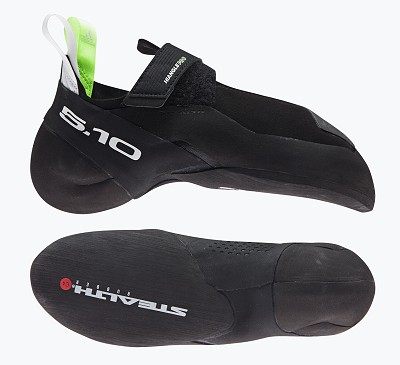
























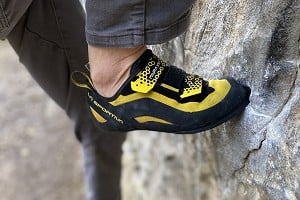
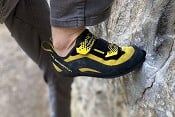
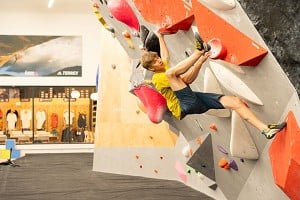
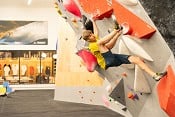


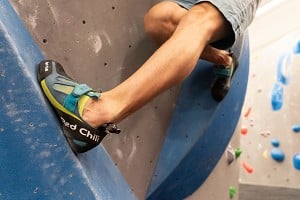
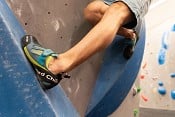
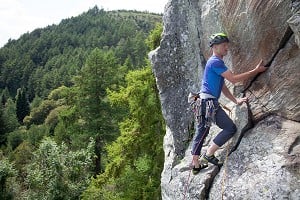
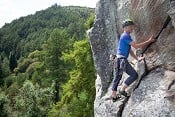

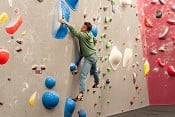
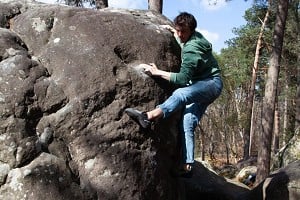
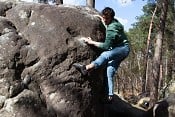
Comments
thanks for this review – good to hear of the finer differences between the models of this line. especially how the pro’s adaptations change its fit. that’s good knowledge. :)
i am a bit puzzled, though, when you write ‘It is, as you'd expect from a shoe of this nature, highly assymetrical in its profile’. when the shots of the shoes’ soles show that the toebox points pretty much in the direction of the line from the heel forward, and its front isn’t even shaped in a way that would make it look more inward-pointing. maybe i’m misunderstanding what asymmetry means, but on a scale from tarantula to drago, their top–down view seem to fall way more towards the former than to the latter.
Funnily enough I wrote this review a fair few months ago now and had to re-read it to remember quite what I'd written. Upon reading that particular section I do wonder quite what I was on about, because as you say - they're not highly asymmetrical, but are asymmetrical (if that makes sense).
Alongside the Hiangle I've been using the new Scarpa Boostics, which are the very definition of asymmetric, and I've attached a photo of the two side by side, with a Drago LV just to their right, just to compare.
I'll get the wording updated so that it's clearer.
definitely makes sense! and your photo makes the point apparent as well – i don’t think i’ve noticed their sideways curve quite as much on the usual product photos.
thanks, rob!